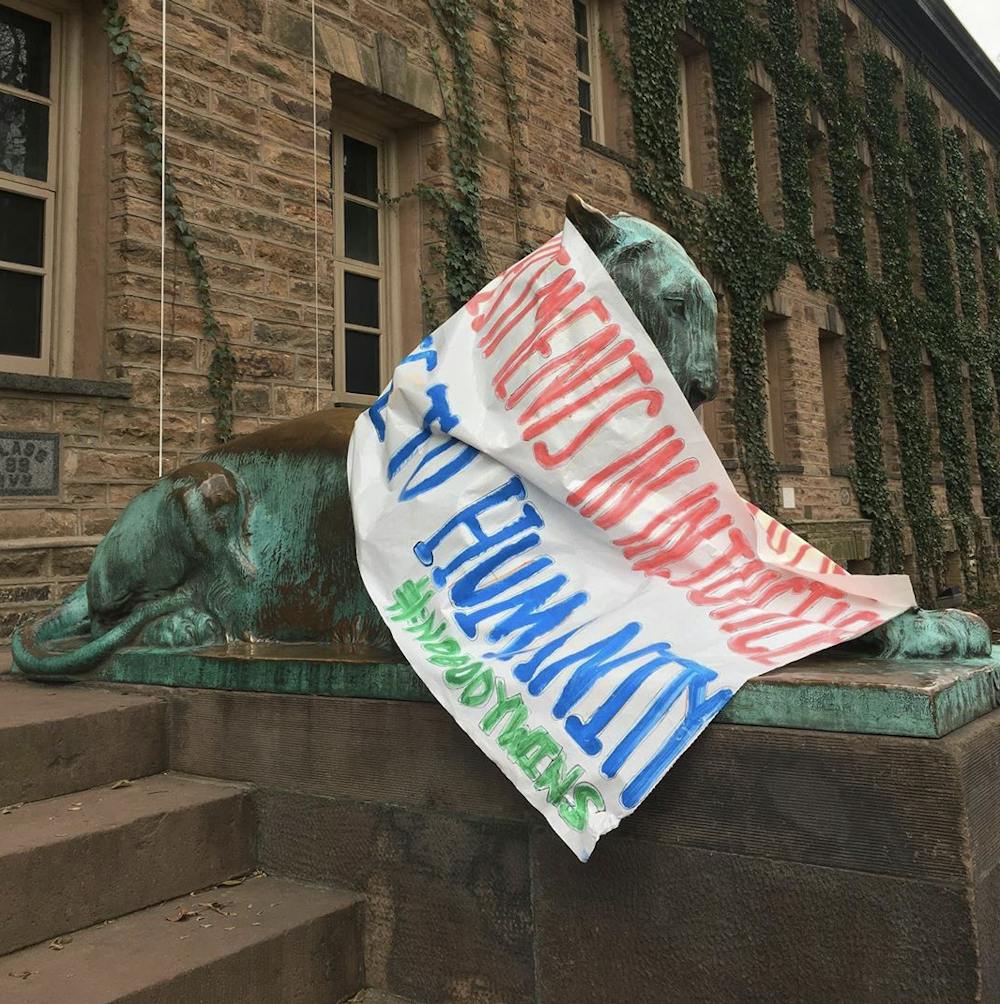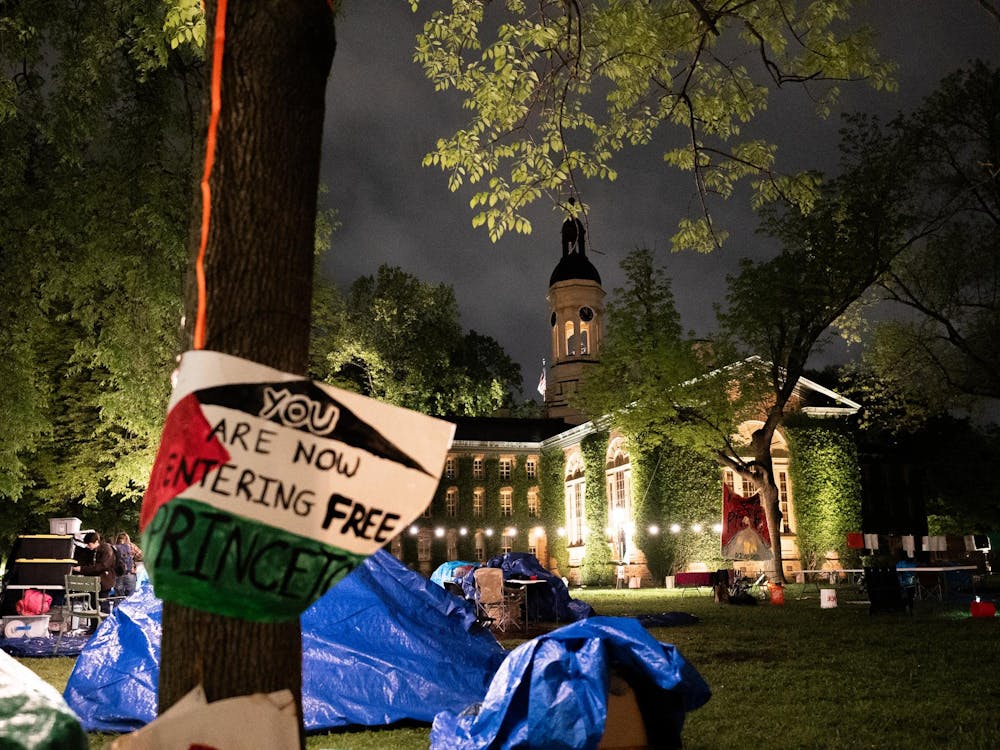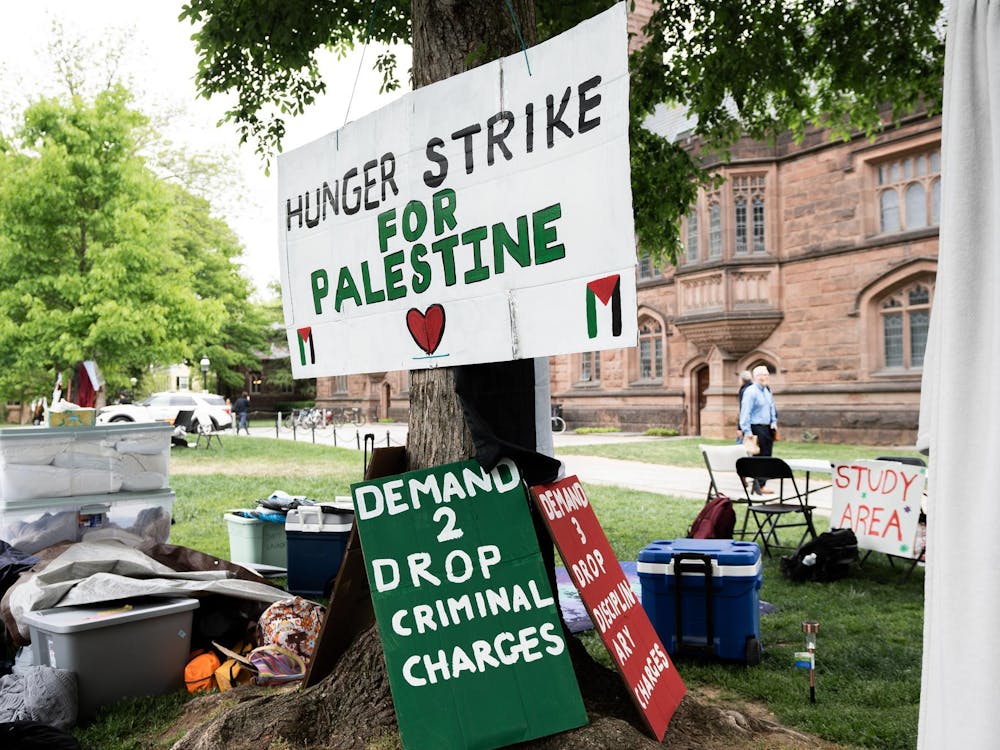“Princeton divest, oh yeah! Just like the rest, oh yeah!”
This chant echoed through campus decades ago, during the movement for divestment from the apartheid regime in South Africa. On Feb. 13, 2020, it rang out again outside Nassau Hall.
Divest Princeton, a coalition of students, faculty, and alumni calling for University divestment from fossil fuels, submitted a proposal to the Council of the Princeton University Community (CPUC) Resources Committee last year. Soon, the Committee will either reject the proposal or recommend it to the Board of Trustees for final consideration. Although the proposal is now out of the group’s hands, their work hasn't stopped: events such as the February demonstration aim to increase pressure on the decision.
The Feb. 13 event lasted all day — Divest Princeton members took shifts to read their proposal aloud outside of Frist Campus Center. The group then marched to Nassau Hall.
Since the proposal’s submission in February 2020, the cause has picked up momentum in the student body. Last November, a USG Referendum passed with 82 percent of undergraduates in support of calling on the Board to both divest from holdings in the fossil fuel industry and disassociate from companies who spread climate misinformation or plan to “develop fossil fuel resources whose emissions would exceed Science Based Targets adopted in accordance with the United Nations Framework Convention on Climate Change.”
In the same month, The Daily Princetonian editorial board endorsed divestment from fossil fuels, a change from 2015 when, in response to a similar proposal, it called on the University Resources Committee to “reject this effort to politicize the endowment.”
These indications of support — though heartening to student leaders like Anna Hiltner ’23, co-coordinator of Divest Princeton — are far from all that this proposal’s approval banks on. Past campus divestment movements, most unsuccessful, provide a long legacy of examples for what current activists may expect.
“Divestment”: The University Definition
A 1987 Statement of the Trustees on Selective Divestiture identifies divestment as “an extremely serious step — one taken only in the most compelling circumstances.”
When community members call for divestment, they advocate for the withdrawal of current direct holdings in complicit companies as well as the prevention of future investments. Once the Trustees adopt a policy of divestment, they also must decline to accept gifts from those companies. According to the 1987 statement, “for Princeton, divestiture means disassociation.”
In 1970, the University established an advisory group to consider questions about the social responsibility of the University with its endowment portfolio. Made up of students, faculty, and staff, the Council of the Princeton University Community (CPUC) Resources Committee can recommend policies for the Board. However, the Board is not obligated to listen to Committee suggestions.
In 1997, the Board adopted guidelines by which the Resources Committee should evaluate issues relating to divestiture. The guidelines emphasize that there “is a strong presumption against the University taking a political position or playing an active role with respect to external issues of a political, social, or moral character.”

The guidelines also state that for the Committee to recommend divestment, there should be “sustained campus interest” and support for divestment, “a central University value clearly at stake,” and “a consensus on how the University should respond.”
Since the implementation of these guidelines, there have been multiple calls by students and faculty for divestment, the vast majority of which have been rejected by the Resources Committee and did not reach the Trustees.
The Board has only voted to adopt policies of divestiture twice in University history — once in 1986 with regards to holdings in apartheid South Africa, and once in 2006 regarding genocide in the Darfur region of Sudan. Other divestment movements, whose proposals were rejected by the Resources Committee, include a 2013 faculty petition to divest from firearms, calls in 2014 regarding divestment from Israeli occupation, and an ongoing movement to divest from private prisons.
Hiltner summed up activist frustrations: “roadblocks to getting a proposal passed through the Resources Committee make it a lot more difficult for students to enact change on campus.”
While the guidelines state that both community consensus and a core University value at stake are necessary, Hiltner argued that there are “no official stated values of the University,” nor is there a “standard for demonstrated consensus.” In addition to the narrow criteria for the Resources Committee to approve a proposal, Hiltner said another “roadblock would be the lack of transparency from the University administration,” noting that the Princeton University Investment Company (PRINCO) manages the University’s endowment portfolio and does not reveal what companies it has holdings in.
Despite these difficulties, students and community members continue to advocate for divestment from fossil fuels through Divest Princeton.
Rejected proposals, building momentum: a look at Divest Princeton’s forebears
The push for the University to divest from the fossil fuel industry began in 2013 when Students United for a Responsible Global Environment (SURGE) created a petition that garnered over 500 signatures from students, parents, and alumni.
The next year, a campaign called the Princeton Sustainable Investment Initiative (PSII) submitted a proposal with over 1,300 signatures from the community “asking the University to manage its endowment in a manner that reduces its financial support of environmental degradation.” The proposal called on the University to adopt the United Nations’ Principles for Responsible Investment, calculate and report the carbon footprint of the endowment, and create guidelines for divestment from companies with “egregiously unsustainable practices” such as those in the fossil fuel industry.
In 2015, the Resources Committee reviewed and ultimately rejected the proposal. The Committee reasoned that the University “has a specific presumption against taking symbolic stands,” and therefore could not adopt the United Nations’ Principles for Responsible Investment. Concerning the proposed calculation and publication of the endowment’s carbon footprint, the Committee responded that implementation of such practices would be “costly and time-consuming.”
Finally, addressing the demand for the University to “shift investments away from those with egregiously unsustainable practices such as fossil fuel extraction,” the Committee noted that the University’s divestment policy “requires disassociation from any company or groups of companies whose policies or practices are so abhorrent to the community that a decision is made to divest.”
They cited the letter of President Christopher Eisgruber ’83 to the Committee, where he wrote: “These companies do not meet the disassociation standard. Every member of the Princeton community associates with energy companies and benefits from what they do.”
The road ahead: Divest Princeton today
According to the Divest Princeton website, the next major wave of the movement came in 2019, when two alumni, Aita Amaize ’07 and Anna Liebowitz ’09, devised the strategy of urging students and alumni to withhold donations from the University until it divested from fossil fuels.
Amaize and Liebowitz teamed up with Tom Taylor MPA ’21 and Micah Fletcher GS to write an open letter to President Eisgruber titled “No Donations Until Divestment.” As of Jan. 26, 2021, the letter has 2,141 signatures from members of the University community, including students, faculty, parents, staff, and alumni. Prominent figures like Jane Goodall have also endorsed it.
“This is the largest call for no donations that the University has ever seen,” said Ryan Warsing MPA ’21, co-coordinator of Divest Princeton. Warsing is a guest contributor for the Daily Princetonian.
Taylor said they felt the pledge would make a particular impact on the University since it is said to have the highest rate of alumni giving in the United States.
According to Taylor, one powerful aspect of Divest Princeton, which formed and started calling meetings after the “No Donations Until Divestment” letter was written, is that it is “a genuine cross section of the Princeton community: undergrads, grad students, and alumni.”
Andrew Kinaci ’10, who worked with SURGE in 2013 on alumni outreach, also praised the “cross-generational participation” of the movement today, as opposed to the “small handful of alumni” they had back then. For Kinaci, it is clear from the momentum of the current movement that attitudes have shifted since his time on campus.
Also, Taylor noted, other universities are taking action.
“Columbia has just announced divestment, so the ball is rolling,” he said. “It’s just a matter of when Princeton moves.” Cornell, Brown, and other prestigious academic institutions like Oxford have already committed to divesting from fossil fuels.
“If we want to call ourselves a global leader,” Warsing said, “we have to actually lead.”
Hiltner, Warsing, and Taylor all expressed hope that the Resources Committee may take a different stance this time, since the University recently committed to becoming carbon neutral. In April 2019, the University published its Sustainability Action Plan, with one stated goal being to reach net-zero campus greenhouse gas emissions by 2046.
The organizers believe that their proposal met the guidelines of the Resources Committee. To “sustained campus interest,” they answer that their movement has been gaining traction since 2013. “Consensus on how the University should respond,” they argue, is implied by the thousands of signatures on their open letter “No Donations Until Divestment.” And finally, in Warsing’s words, the Sustainability Action Plan proves that “climate sustainability is 100 percent a core value of the University” — which, to his mind, meets the third requirement of the CPUC.
According to University Spokesperson Ben Chang, the Resources Committee is “actively deliberating on this topic and giving it thoughtful consideration.”
“We value the productive engagement with a range of stakeholders, including members of Divest Princeton, of the ongoing CPUC Resources Committee process,” Chang said. “The process — built to consider many viewpoints and inputs — has to continue to run its course, and we maintain confidence in this deliberative approach towards reaching the Committee’s recommendations.”
The Resources Committee is expected to respond to the proposal sometime in the next few weeks.









